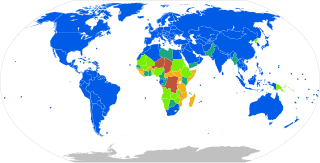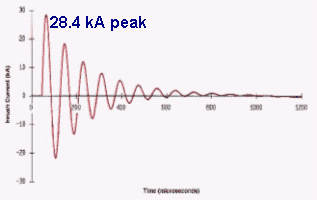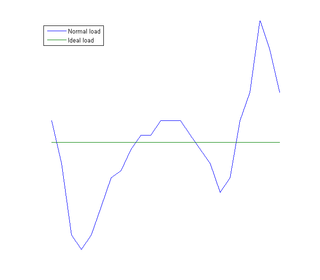
In electrical engineering, a transformer is a passive component that transfers electrical energy from one electrical circuit to another circuit, or multiple circuits. A varying current in any coil of the transformer produces a varying magnetic flux in the transformer's core, which induces a varying electromotive force (EMF) across any other coils wound around the same core. Electrical energy can be transferred between separate coils without a metallic (conductive) connection between the two circuits. Faraday's law of induction, discovered in 1831, describes the induced voltage effect in any coil due to a changing magnetic flux encircled by the coil.

A vacuum tube, electron tube, valve, or tube, is a device that controls electric current flow in a high vacuum between electrodes to which an electric potential difference has been applied.

Mains electricity or utility power, grid power, domestic power, and wall power, or, in some parts of Canada, hydro, is a general-purpose alternating-current (AC) electric power supply. It is the form of electrical power that is delivered to homes and businesses through the electrical grid in many parts of the world. People use this electricity to power everyday items by plugging them into a wall outlet.

A power outage is the loss of the electrical power network supply to an end user.

A substation is a part of an electrical generation, transmission, and distribution system. Substations transform voltage from high to low, or the reverse, or perform any of several other important functions. Between the generating station and consumer, electric power may flow through several substations at different voltage levels. A substation may include transformers to change voltage levels between high transmission voltages and lower distribution voltages, or at the interconnection of two different transmission voltages. They are a common component of the infrastructure. There are 55,000 substations in the United States.

Power engineering, also called power systems engineering, is a subfield of electrical engineering that deals with the generation, transmission, distribution, and utilization of electric power, and the electrical apparatus connected to such systems. Although much of the field is concerned with the problems of three-phase AC power – the standard for large-scale power transmission and distribution across the modern world – a significant fraction of the field is concerned with the conversion between AC and DC power and the development of specialized power systems such as those used in aircraft or for electric railway networks. Power engineering draws the majority of its theoretical base from electrical engineering and mechanical engineering.

Bharat Heavy Electricals Limited (BHEL) is an Indian central public sector undertaking and the largest government-owned power generation equipment manufacturer. It is owned by the Government of India, with administrative control by the Ministry of Heavy Industries. Established in 1956 with the help of Soviet technology, BHEL is based in New Delhi.

The CBU-97 Sensor Fuzed Weapon is a United States Air Force 1,000-pound (450 kg)-class freefall Cluster Bomb Unit. It was developed and produced by Textron Defense Systems. A CBU-97 used in conjunction with the Wind Corrected Munitions Dispenser guidance tail kit is converted to a precision-guided weapon, and the combination is designated CBU-105.

Inrush current, input surge current, or switch-on surge is the maximal instantaneous input current drawn by an electrical device when first turned on. Alternating-current electric motors and transformers may draw several times their normal full-load current when first energized, for a few cycles of the input waveform. Power converters also often have inrush currents much higher than their steady-state currents, due to the charging current of the input capacitance. The selection of over-current-protection devices such as fuses and circuit breakers is made more complicated when high inrush currents must be tolerated. The over-current protection must react quickly to overload or short-circuit faults but must not interrupt the circuit when the inrush current flows.
An electrolaser is a type of electroshock weapon that is also a directed-energy weapon. It uses lasers to form an electrically conductive laser-induced plasma channel (LIPC). A fraction of a second later, a powerful electric current is sent down this plasma channel and delivered to the target, thus functioning overall as a large-scale, high energy, long-distance version of the Taser electroshock gun.
In electric power distribution and transmission, a Buchholz relay is a safety device mounted on some oil-filled power transformers and reactors, equipped with an external overhead oil reservoir called a "conservator".

Galvanic isolation is a principle of isolating functional sections of electrical systems to prevent current flow; no direct conduction path is permitted.
A brownout is a drop in the magnitude of voltage in an electrical power system.

Load management, also known as demand-side management (DSM), is the process of balancing the supply of electricity on the network with the electrical load by adjusting or controlling the load rather than the power station output. This can be achieved by direct intervention of the utility in real time, by the use of frequency sensitive relays triggering the circuit breakers, by time clocks, or by using special tariffs to influence consumer behavior. Load management allows utilities to reduce demand for electricity during peak usage times, which can, in turn, reduce costs by eliminating the need for peaking power plants. In addition, some peaking power plants can take more than an hour to bring on-line which makes load management even more critical should a plant go off-line unexpectedly for example. Load management can also help reduce harmful emissions, since peaking plants or backup generators are often dirtier and less efficient than base load power plants. New load-management technologies are constantly under development — both by private industry and public entities.

An electric power system is a network of electrical components deployed to supply, transfer, and use electric power. An example of a power system is the electrical grid that provides power to homes and industries within an extended area. The electrical grid can be broadly divided into the generators that supply the power, the transmission system that carries the power from the generating centers to the load centers, and the distribution system that feeds the power to nearby homes and industries.

An electrical grid is an interconnected network for electricity delivery from producers to consumers. Electrical grids consist of power stations, electrical substations to step voltage up or down, electric power transmission to carry power over long distances, and finally electric power distribution to customers. In that last step, voltage is stepped down again to the required service voltage. Power stations are typically built close to energy sources and far from densely populated areas. Electrical grids vary in size and can cover whole countries or continents. From small to large there are microgrids, wide area synchronous grids, and super grids.

The 2010 Chile blackout was an electric power outage that affected most of Chile on March 14, 2010. It began at 8:44 pm on Sunday and continued into the next day. The power was restored in a few hours in some areas, and by midnight in most areas, except in the Biobío Region.
An electromagnetic pulse (EMP), also referred to as a transient electromagnetic disturbance (TED), is a brief burst of electromagnetic energy. The origin of an EMP can be natural or artificial, and can occur as an electromagnetic field, as an electric field, as a magnetic field, or as a conducted electric current. The electromagnetic interference caused by an EMP can disrupt communications and damage electronic equipment. An EMP such as a lightning strike can physically damage objects such as buildings and aircraft. The management of EMP effects is a branch of electromagnetic compatibility (EMC) engineering.
This glossary of electrical and electronics engineering is a list of definitions of terms and concepts related specifically to electrical engineering and electronics engineering. For terms related to engineering in general, see Glossary of engineering.













